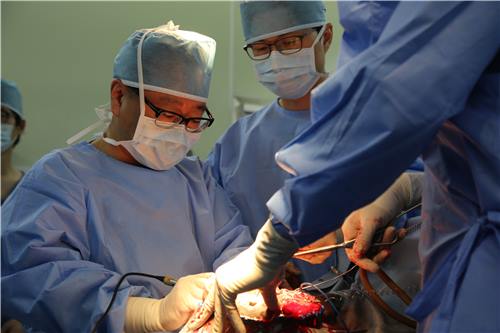Amid Underwhelming 2017 Economic Outlook, South Korea Announces Plan to Invest Heavily in Advanced Technology
 As 2016 draws to a close, industries and governments are examining their economic prospects for the upcoming year. For South Korea, 2017 looks like it’s going to be underwhelming. Political uncertainty caused by the impeachment of South Korean president Park Geun-hye, the US election of Donald Trump, and Great Britain’s exit from the European Union are expected to affect both corporate investment and consumer spending. A rise in US interest rates, as well as slowing growth in China, could have negative impacts as well.
As 2016 draws to a close, industries and governments are examining their economic prospects for the upcoming year. For South Korea, 2017 looks like it’s going to be underwhelming. Political uncertainty caused by the impeachment of South Korean president Park Geun-hye, the US election of Donald Trump, and Great Britain’s exit from the European Union are expected to affect both corporate investment and consumer spending. A rise in US interest rates, as well as slowing growth in China, could have negative impacts as well.
No disastrous predictions are being made at this time, but the Hyundai Research Institute recently released a report forecasting only mild recovery for the technology, auto, steel and mechanics industries, while the construction and petrochemical industries are expected to see slowing growth. The shipbuilding industry, a vital one for South Korea, has been plagued with major losses since 2015, and things aren’t expected to get any better in 2017.
![]() It’s not all bad news, though. As South Korea’s traditional industries stagnate or founder, the country is wisely looking towards new and advanced technology to drive the future economy. Earlier this year, the Hyundai Research Institute published a report cautioning South Korea about being ill-prepared for the Fourth Industrial Revolution and the changing landscape of business and industry – and the country seems to be taking the advice to heart. Today, the South Korean government announced a plan to invest heavily in several emerging technology sectors, including 3D printing.
It’s not all bad news, though. As South Korea’s traditional industries stagnate or founder, the country is wisely looking towards new and advanced technology to drive the future economy. Earlier this year, the Hyundai Research Institute published a report cautioning South Korea about being ill-prepared for the Fourth Industrial Revolution and the changing landscape of business and industry – and the country seems to be taking the advice to heart. Today, the South Korean government announced a plan to invest heavily in several emerging technology sectors, including 3D printing.
The financial details of the investment have not been disclosed, but in addition to 3D printing, the government plans to focus on the areas of fifth-generation telecommunications, virtual and augmented reality, self-driving vehicles, the Internet of Things, and artificial intelligence-based security services. In particular, the government plans to help the aviation and automotive industries integrate 3D printing into their manufacturing processes as quickly as possible.
While the military and medical sectors have already shown some initiative in using 3D printing technology, with some impressive results, the government is encouraging them to push forward with the technology even more aggressively, urging the medical industry to use 3D printing to develop artificial bones, implants and assistive devices. The railroad industry is also being encouraged to incorporate the technology.
Looking ahead a few years, the South Korean government plans to launch a commercial service of super-fast fifth-generation (5G) telecom networks in 2020, and will offer carriers a high-frequency 5G spectrum in 2019. The government isn’t abandoning the struggling shipbuilding industry, either. The sector is being encouraged to adapt by incorporating new technology such as the Internet of Things and big data, and we’ve already seen the industry moving towards 3D printing as a manufacturing method.
Of critical importance to not just the economy but national security is cybersecurity. As cyberhacking emerges as an increasingly serious threat to the governments and businesses of many developed nations, South Korea is wisely allocating resources to the development of artificial intelligence-based security services. Goals include creating a firewall that will allow computers to develop their own safeguards against cyberattacks, and an entire government body will be formed for the purpose of facilitating national cybersecurity. Discuss in the South Korea forum at 3DPB.com.
[Source: Yonhap]
Subscribe to Our Email Newsletter
Stay up-to-date on all the latest news from the 3D printing industry and receive information and offers from third party vendors.
You May Also Like
Profiling a Construction 3D Printing Pioneer: US Army Corps of Engineers’ Megan Kreiger
The world of construction 3D printing is still so new that the true experts can probably be counted on two hands. Among them is Megan Kreiger, Portfolio Manager of Additive...
US Army Corps of Engineers Taps Lincoln Electric & Eaton for Largest 3D Printed US Civil Works Part
The Soo Locks sit on the US-Canadian border, enabling maritime travel between Lake Superior and Lake Huron, from which ships can reach the rest of the Great Lakes. Crafts carrying...
Construction 3D Printing CEO Reflects on Being Female in Construction
Natalie Wadley, CEO of ChangeMaker3D, could hear the words of her daughter sitting next to her resounding in her head. “Mum, MUM, you’ve won!” Wadley had just won the prestigious...
1Print to Commercialize 3D Printed Coastal Resilience Solutions
1Print, a company that specializes in deploying additive construction (AC) for infrastructure projects, has entered an agreement with the University of Miami (UM) to accelerate commercialization of the SEAHIVE shoreline...






























